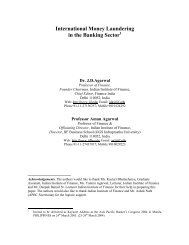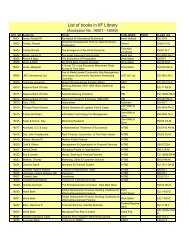Dairy Co-operative and Rural Development - Indian Institute of ...
Dairy Co-operative and Rural Development - Indian Institute of ...
Dairy Co-operative and Rural Development - Indian Institute of ...
Create successful ePaper yourself
Turn your PDF publications into a flip-book with our unique Google optimized e-Paper software.
Abstract <strong>of</strong> Doctoral Dissertations 407<br />
Gujarat as a model with the above object in view. The Himalayan <strong>Co</strong><strong>operative</strong><br />
Milk Producers’ Union Limited (HIMUL) was formed at the foot<br />
<strong>of</strong> the Himalayas in West Bengal in 1973 as a part <strong>of</strong> this programme like<br />
other states <strong>of</strong> the country.<br />
This study deals with the analysis- as to how far the Operation Flood<br />
Programme i.e. replicating the ANAND model programme taken by the<br />
N.D.D.B. is achieved in India.<br />
This analysis depicts that the programme which was taken with a view<br />
to replicating the ANAND model has not achieved success through out the<br />
country. Besides, this programme did not consider local geographical <strong>and</strong><br />
socioeconomic aspect at the time <strong>of</strong> copying ANAND model exactly. As a<br />
result in many cases invested capital <strong>of</strong> Operation Flood Programme could<br />
not yield any favourable result.<br />
According to Operation Flood Programme many Milk Producers’ <strong>Co</strong><strong>operative</strong><br />
have been formed in this vast country. For the benefit <strong>of</strong> detailed<br />
analysis only two <strong>Co</strong>-<strong>operative</strong> Milk Producers’ Union Limited - The Kaira<br />
District (ANAND) <strong>Co</strong>-<strong>operative</strong> Milk Producers’ Union Limited <strong>and</strong> The<br />
Himalayan <strong>Co</strong>-<strong>operative</strong> Milk Producers’ Union Limited, have been taken<br />
into account.<br />
This study is divided into eight chapters. The first four chapters contain<br />
the history <strong>of</strong> <strong>Dairy</strong> <strong>Co</strong>-<strong>operative</strong>s in India <strong>and</strong> elaborate discussion <strong>of</strong> Operation<br />
Flood Programmes in addition to the introduction. Besides, these chapters<br />
include the history <strong>of</strong> the formation process <strong>of</strong> AMUL <strong>and</strong> HIMUL.<br />
In this analysis, problems have been discussed in three stages in the next<br />
three chapters. In the first stage growth <strong>and</strong> performance, in the second stage<br />
financial performance <strong>and</strong> in the last stage influence <strong>of</strong> <strong>Dairy</strong> <strong>Co</strong>-<strong>operative</strong>s<br />
on rural economy have been discussed. My inference from the detailed analysis<br />
has been included in the last chapter.<br />
History <strong>of</strong> <strong>Dairy</strong> <strong>Co</strong>-<strong>operative</strong> in India<br />
The <strong>Co</strong>-<strong>operative</strong> movement started in India in the last decade <strong>of</strong> the<br />
19th Century with two objects in view, i.e. to protect the farmers from the<br />
h<strong>and</strong>s <strong>of</strong> the private money lenders <strong>and</strong> to improve their economic condition.<br />
Madras province was the birth-place <strong>of</strong> this movement. With the setting up<br />
<strong>of</strong> an Agricultural <strong>Co</strong>-<strong>operative</strong> Banks there the movement took root in our<br />
L<strong>and</strong> <strong>and</strong> slowly gained strength. However, the growth <strong>of</strong> <strong>Co</strong>-<strong>operative</strong><br />
movement in India during British rule was very slow <strong>and</strong> haphazard one. In<br />
most <strong>of</strong> the cases, the provincial governments took the lead. The foreign<br />
ruler had only made some committees or framed a few rules <strong>and</strong> regulations.<br />
But they did not take any wide-ranging programme to spread the movement<br />
all over the country.<br />
The golden era <strong>of</strong> <strong>Co</strong>-<strong>operative</strong> movement began after India had won<br />
freedom. Within two decades <strong>of</strong> independence the membership <strong>of</strong> primary<br />
societies had increased four times while the share capital <strong>and</strong> working capital<br />
increased 23 <strong>and</strong> 31 times respectively.
















